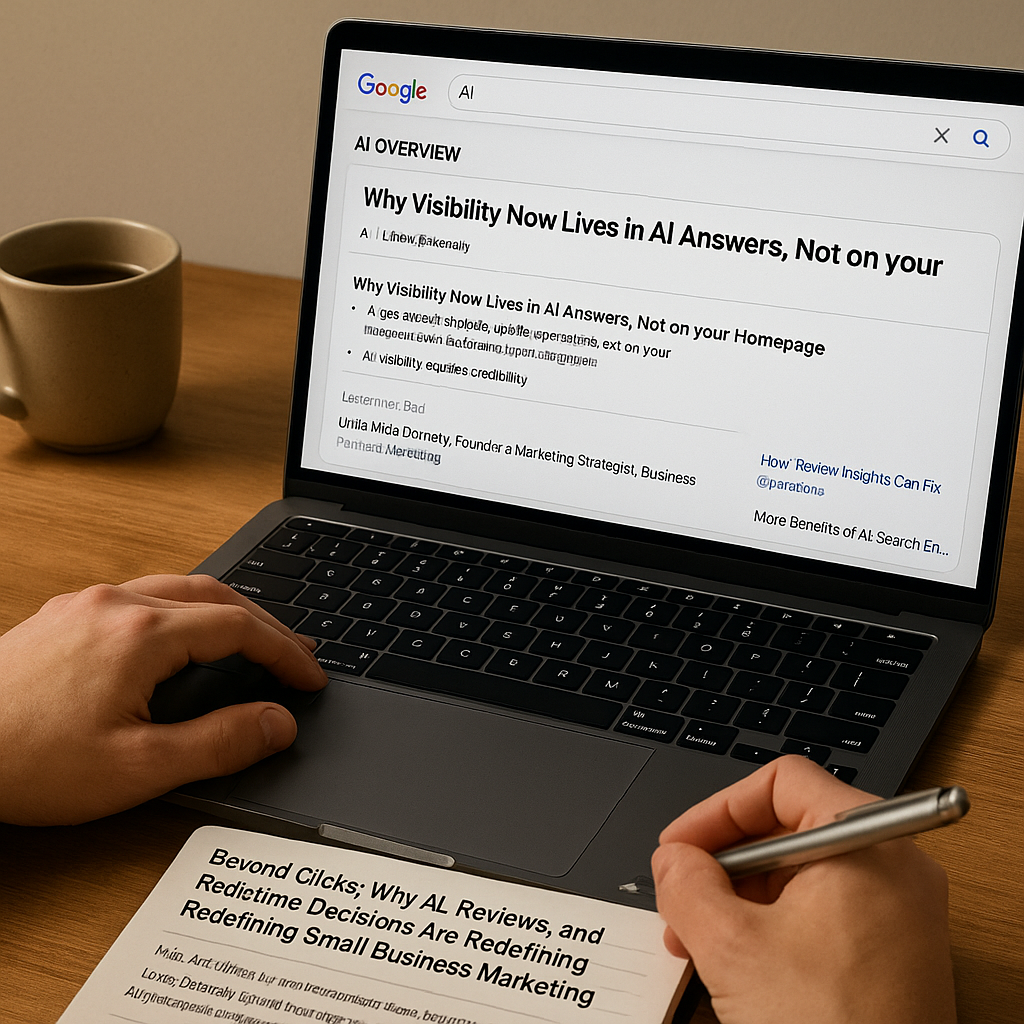I want you to think about this for a second: Over 10 million blog posts are published every single day. (Source: Semrush).
Ten. Million.
Now, let’s be honest. As a small business owner, how many “blogs” has your marketing person (or maybe you, at 11 PM on a Tuesday) written and just… thrown into the void?
You write about “5 Tips for Plumbers.” You write about “What to Look for in a Family Lawyer.” You check the “blog” box for the month and you wait. And… nothing happens. No calls. No new traffic. Just crickets.
My name is Linda Donnelly, and as the owner of Business Solutions Marketing Group, I’ve spent over a decade helping small businesses and law firms in this exact situation. I’m here to tell you why your old strategy isn’t working anymore.
It’s not your fault. The entire game has changed.
The old game was Search Engine Optimization (SEO). It was a “keyword” game. You picked a phrase, you put it on a page, and you hoped to rank #1. The new game is Answer Engine Optimization (AEO). And the only way to win is by building Topical Authority.
This sounds like fancy marketing jargon, I know. But it’s the single most important concept you need to understand to win on Google for the next decade. And it’s the only way you’re going to show up in Google’s new “AI Overviews.”
So let’s break it down. What is it, why does it matter, and how can you (a busy business owner) actually do it?

Key Takeaways: What You Need to Know Right Now
I know you’re busy. If you only read one part, read this:
- “Authority” is the New SEO: Topical Authority is the act of proving to Google that you are a deep, trustworthy expert on an entire subject, not just one keyword.
- The AI is Here (And It’s Hungry): Google’s new AI Overviews (the big answer boxes) hate “thin” content. The AI is specifically designed to find and cite authorities.
- The “Pillar & Cluster” Model is Your Map: This is the how. You stop writing random blogs. You start building a “Pillar” (a 3,000-word “Ultimate Guide”) and “Clusters” (in-depth 1,500-word articles) that all link together.
- “One-and-Done” Blogging is Dead: Writing one 500-word blog post is a waste of your time and money. Google will ignore it. You must go deep or go home.
- This Builds E-E-A-T: This strategy is the most powerful way to build your “Expertise, Authoritativeness, and Trust” (E-A-T), which is Google’s #1 ranking factor.
- How We Help: This is exactly what we do at BSMG. We’re not just “blog writers.” We are authority builders. We create the entire strategy for you.
What is Topical Authority (And Why Isn’t It Just “Blogging”?)
Let’s use a simple analogy.
Imagine your website is a library.
- Old SEO (Blogging): You have a messy library. You have one book on “Divorce” next to one on “Car Wrecks.” You have a thin pamphlet on “Plumbing.” A customer (Google) walks in, gets confused, and leaves.
- New AEO (Topical Authority): You have a perfectly organized library. You have a giant, clearly-marked sign that says: “The Complete Guide to Family Law.” And on that shelf, you have 10 thick, in-depth books (your cluster posts) on “Child Custody,” “Alimony,” “Property Division,” etc.
When Google’s AI crawls your site, which “library” do you think it trusts?
Topical Authority is the art of building the best library on the internet for your specific topic.
It’s a strategic decision to go deep instead of wide. You are telling Google, “Hey, don’t just send me traffic for ‘Greensboro lawyer.’ Send me all the traffic for everything related to family law in Greensboro, because I am the expert. I’ve written the book on it. Literally.”
A “blog” is a single post. “Topical Authority” is a web of interconnected, in-depth content that proves you’re the authority.
Why Topical Authority is Your Only Defense Against Google’s AI
If you’re still on the fence, this is the part you need to read. The shift to Topical Authority is being forced on us by the rise of AI.
You’ve seen them. The “AI Overviews” at the top of Google. The “Ask Maps” feature. This is Google’s AI (Gemini) summarizing the internet so the user doesn’t have to click.
The AI’s #1 Job: Find the “Source of Truth” The AI is terrified of being wrong. It’s terrified of “hallucinating” and giving bad, dangerous advice (especially for our legal or medical clients). So, its entire goal is to find the most trustworthy, authoritative, and experienced source to quote.
It is actively hunting for E-E-A-T. That’s Experience, Expertise, Authoritativeness, and Trust. This isn’t a theory; it’s the core of Google’s Search Quality Rater Guidelines.
How do you prove you have E-E-A-T?
- You can’t just stuff “expert” on your page 10 times.
- You can’t just write one 500-word blog post.
- You PROVE it by building Topical Authority.
When the AI crawls your “library” and sees your 3,000-word “Pillar” page and your 10 in-depth “Cluster” posts, all linked together, you are proving your Expertise, Authoritativeness, and Trust. You are showing your work.
Your “thin” competitor with one 500-word blog? They are invisible to the AI. This is the new “ranking #1.” Your goal is to be the source the AI quotes.
How It Works: The “Pillar and Cluster” Model (Your New Content Map)
Okay, so how do we do this? This is the “secret sauce” we’ve been using at Business Solutions Marketing Group for years. It’s called the “Pillar and Cluster” model.
It’s a simple, powerful structure.
1. The Pillar Page (Your “Ultimate Guide”)
- What it is: This is the “hub” of your library. It’s a single, massive (think 2,500-3,000+ words) page that covers a broad topic from top to bottom.
- The Topic: It targets a big, high-volume keyword.
- Lawyer Example: “The Complete Guide to Wrongful Death Claims in North Carolina”
- Plumber Example: “The Ultimate Guide to Tankless Water Heaters”
- Our Example: “What is Reputation Management?“
- The Goal: This page covers the A-Z of the topic… but lightly. It answers the “who, what, when, where, why.” For the “how,” it links out to your Cluster pages.
2. The Cluster Pages (Your “Deep Dives”)
- What they are: These are your “books” on the shelf. They are shorter (but still deep—think 1,500+ words) articles that take one single sub-topic from your Pillar and explode it with detail.
- The Topic: They target a “long-tail” keyword (a specific question).
- Pillar: “Wrongful Death in NC”
- Cluster 1: “How to Prove a Medical Malpractice Wrongful Death Case”
- Cluster 2: “What is the 2-Year Statute of Limitations for Wrongful Death in NC?”
- Cluster 3: “Who Can File a Wrongful Death Lawsuit?”
- Cluster 4: “Calculating Wrongful Death Damages (What is a Case Worth?)”
3. The “Magic”: The Internal Linking
This is the part everyone gets wrong. This is the “glue” that holds your library together and proves your authority to Google.
- Rule 1: Every single Cluster Page must link up to the Pillar Page. (This tells Google, “This post is part of that main guide.”)
- Rule 2: Your Pillar Page must link down to every single one of its Cluster Pages. (This tells Google, “If you want to go deeper on this sub-topic, go here.”)
- Rule 3 (Pro-Tip): Your Cluster Pages should also link to each other where it makes sense. This is called “contextual linking.”
This spiderweb of internal links does something magical. It creates a “silo” of information. When Google’s AI lands on any page in this cluster, it follows the links and discovers your entire library. It says, “Wow. This isn’t a page. This is a resource. This is an authority.”
And that is the source it will cite in its AI Overview.
Your 4-Step Action Plan to Start Building Authority Today
This is not a “someday” project. This is a “right now” project. The businesses that build this “content moat” will be unbeatable in a year.
Here’s your plan.
Step 1: Find Your “Pillars” (aka Your “Money” Topics)
Get out a piece of paper. What are the 3-5 biggest problems you solve for your customers? Don’t just list “services.” Think “problems.”
- Not: “Family Law”
- Yes: “Going Through a Divorce”
- Not: “Criminal Defense”
- Yes: “I Was Arrested for a DUI”
- Not: “Plumbing”
- Yes: “Fixing a Leaky Pipe”
These are your “Pillars.” These are the broad topics you need to own.
Step 2: Brainstorm Your “Clusters” (The Questions You Answer All Day)
Now, pick one of those Pillars. Let’s say it’s “Going Through a Divorce.” Write down the first 10 questions every new client asks you.
- “How much does a divorce cost?”
- “What’s the difference between separation and divorce in NC?”
- “Who gets the house?”
- “What is alimony?”
- “How do we handle child custody?”
BAM! Those are your first 5 “Cluster” posts. It’s that simple. This is what our Content Marketing team does. We start with your customer’s questions. (Pro-Tip: We also use AI tools to find hundreds of other questions people are Googling, but your brain is the best place to start).
Step 3: Write for Depth, Not for “Fluff”
This is the hard part. Your “5 Tips to a Happy Divorce” blog post (500 words) is dead. Your new post, “How is Alimony Actually Calculated in North Carolina?” needs to be 1,500+ words. It needs to be the best, most helpful answer on the internet. It needs sub-headings, bullet points, and (if you’re a lawyer) links to the actual statutes.
You need to show your work. Go deep. A recent Semrush study on content length confirms that long-form content (3,000+ words) gets more traffic and more backlinks. Why? Because it’s seen as more authoritative.
Step 4: Be Patient and Be Consistent
This is not a “30-day” fix. This is a long-term strategy. You are building a digital asset. You are building a moat around your business. It takes time. But the payoffs are huge. While your competitors are “blogging into the void” with 500-word “fluff” posts, you will be methodically building your library.
In 6-12 months, Google’s AI will not just see you as an option. It will see you as the only logical answer.
“But Linda, This Sounds Like a Lot of Work…”
You are 100% right. It is.
You are a business owner. You are a lawyer. You are a plumber. You are not a full-time publisher, editor, and SEO strategist.
And that’s where we come in.
This is our full-time job. At Business Solutions Marketing Group, we’ve evolved right alongside Google. We aren’t just “blog writers” or a generic “SEO” shop. We are Authority Builders.
This entire, complex process—the “Pillar and Cluster” strategy, the deep-dive Content Marketing, the technical Schema, the crucial GBP Optimization, and the Reputation Management that proves your “Trust”—it’s all part of our holistic strategy.
We take your expertise from your head, and we package it in the exact way Google’s new AI needs to see it. You keep running your business. We’ll make sure you’re the only one Google trusts.
Key Takeaways
- “Topical Authority” is the new SEO. It’s about proving you’re a deep expert on an entire subject, not just a single keyword.
- Google’s AI is Here: AI Overviews (the “answer boxes”) are the new “rank #1.” The AI hates “thin” content and loves to cite “authorities.”
- The “Pillar & Cluster” Model is your map. You build one “Ultimate Guide” (Pillar) and link it to many “Deep Dive” articles (Clusters).
- Go Deep or Go Home: “One-and-done” 500-word blog posts are a waste of money. You must create long-form (1,500+ word) content that actually helps the user.
- This is How You Prove E-E-A-T: This strategy is the best way to demonstrate your Experience, Expertise, Authoritativeness, and Trust to Google.
- Internal Linking is the “Magic”: The “spiderweb” of links connecting your Pillar and Clusters is what proves your authority to the AI.
Common Questions You Might Have
- How is Topical Authority different from just “blogging a lot”?
- “Blogging a lot” is random. It’s “spray and pray.” You write about 10 different, unconnected topics. Topical Authority is strategic. It’s about depth, not breadth. You pick one important topic and write 10-15 deep, interconnected articles all about that one topic.
- How do I even start? What’s my first “Pillar”?
- Easy. Ask yourself: “What is the one service that makes me the most money?” or “What is the one big problem my customers always have?” That is your first Pillar.
- Won’t AI just write all this for me?
- No! This is a huge trap. AI can’t experience anything (the “E” in E-E-A-T). It can’t tell your personal stories or your unique case results. You can use AI to help with outlines or ideas, but the content must be heavily edited by a real human expert (you, or us) to have any authority.
- How long does this take to work?
- This is a long-term strategy, not a quick fix. You are building a digital asset, a “moat” around your business. You will often start to see traction on your “Cluster” posts in 3-6 months, and the full “Authority” effect can take 9-12 months. But the results are durable and last for years.
- I’m a local business. Does this really apply to me?
It applies to you more! A local plumber who builds a “Topical Authority” cluster on “Tankless Water Heaters in Greensboro” will dominate a competitor who just has one page. You are proving to Google you are the local expert.
GBP LInk – https://g.co/kgs/GR8yH4a
LinkedIn – https://www.linkedin.com/company/business-solutions-marketing-group-llc/?viewAsMember=true
Instagram – https://www.instagram.com/business_solutions_mg/
Twitter – https://x.com/BSMGLLC
Facebook – https://www.facebook.com/BusinessSolutionsMarketingGroup
BlueSky: https://bsky.app/profile/bussolutions.bsky.social
TikTok – https://www.tiktok.com/@linda_donnelly
YouTube – https://www.youtube.com/channel/UC4w357-txvxOaHff2hTfSSg





